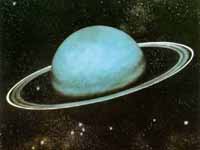New red and blue rings found around Uranus
Two outer rings, one red, the other blue, have been observed around the distant planet Uranus.

While Uranus had been known to have inner rings of neutral color, the newly discovered outer rings show color contrasts that researchers think are caused by light reflected off particles that differ in size from one ring to the other.
The outermost ring is only the second blue ring to have been observed, a team led by Imke de Pater of the University of California, Berkeley, reports in Friday's issue of the journal Science.
Also blue is Saturn's outermost ring, the researchers said. And they noted that each of the known blue rings has a moon embedded within it, while the red rings do not, reports AP.
According to Reuters, The newly discovered outer ring of Uranus is bright blue, for the same reason the Earth's sky is blue -- it is made up of tiny particles, astronomers said on Thursday.
It is "strikingly similar" to Saturn's outer ring, which astronomers last month confirmed was probably generated by one of the planet's moons, Enceladus.
Like Saturn's ring, the Uranus ring also has a small moon in it, called Mab. But Mab is too small and too cold to be spewing a geyser of ice that contributes to the ring as Enceladus is now believed to be doing.
"The outer ring of Saturn is blue and has Enceladus right smack at its brightest spot, and Uranus is strikingly similar, with its blue ring right on top of Mab's orbit," said Imke de Pater, a professor of astronomy at the University of California Berkeley, who helped lead the study.
"I think there is no chance that the blue ring is caused by geyser activity," added de Pater, whose report is published in Friday's issue of the journal Science.
"We don't know what the composition of the particles is."
Mab is probably covered with water ice, like the other moons of Uranus, but that has nothing to do with the ring's color, said de Pater.
"They are blue because they are tiny particles," De Pater said in a telephone interview.
"That is same reason why the sky is blue. You have little particles that scatter light as blue light."
Most other rings around planets in the solar system are red, because of the size of their particles. This is why Uranus's outer ring was missed for so long -- scientists were looking for it in the infrared light spectrum.
O.Ch.
Subscribe to Pravda.Ru Telegram channel, Facebook, RSS!





